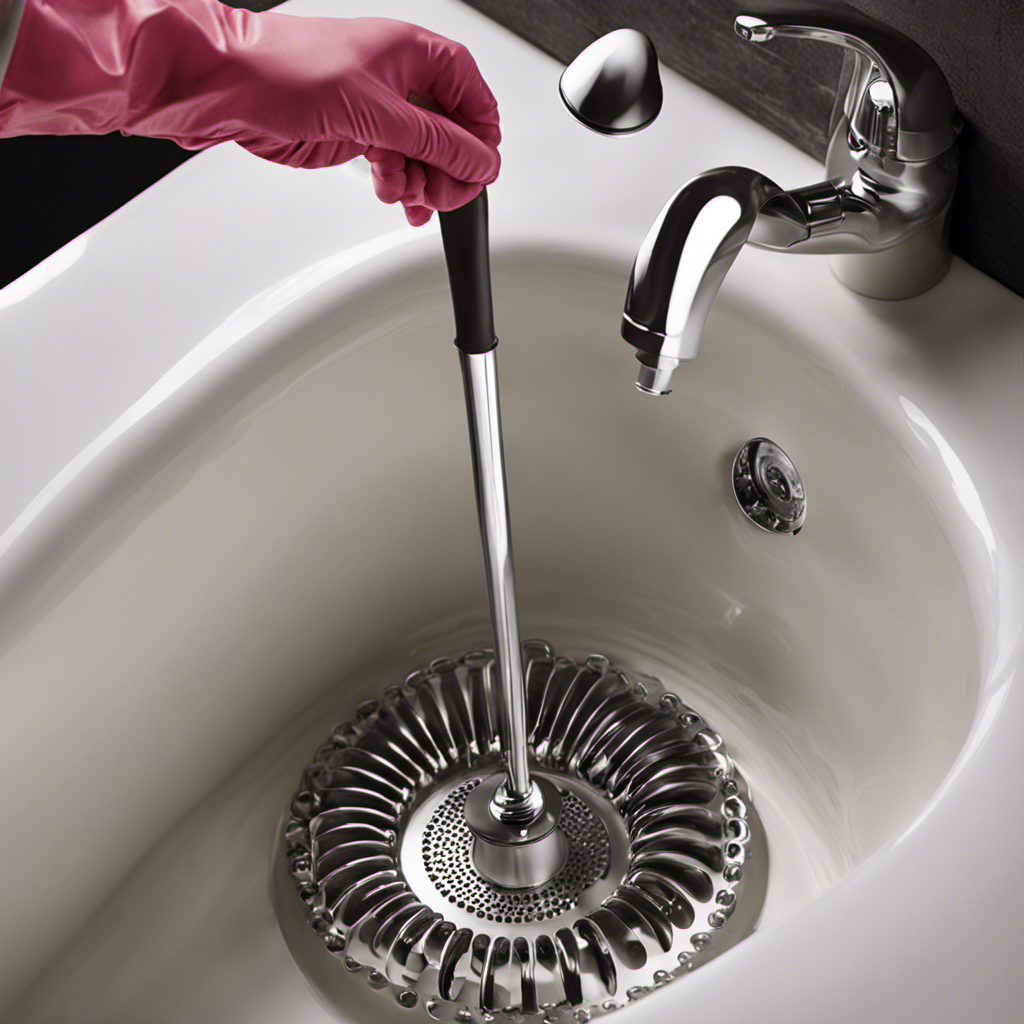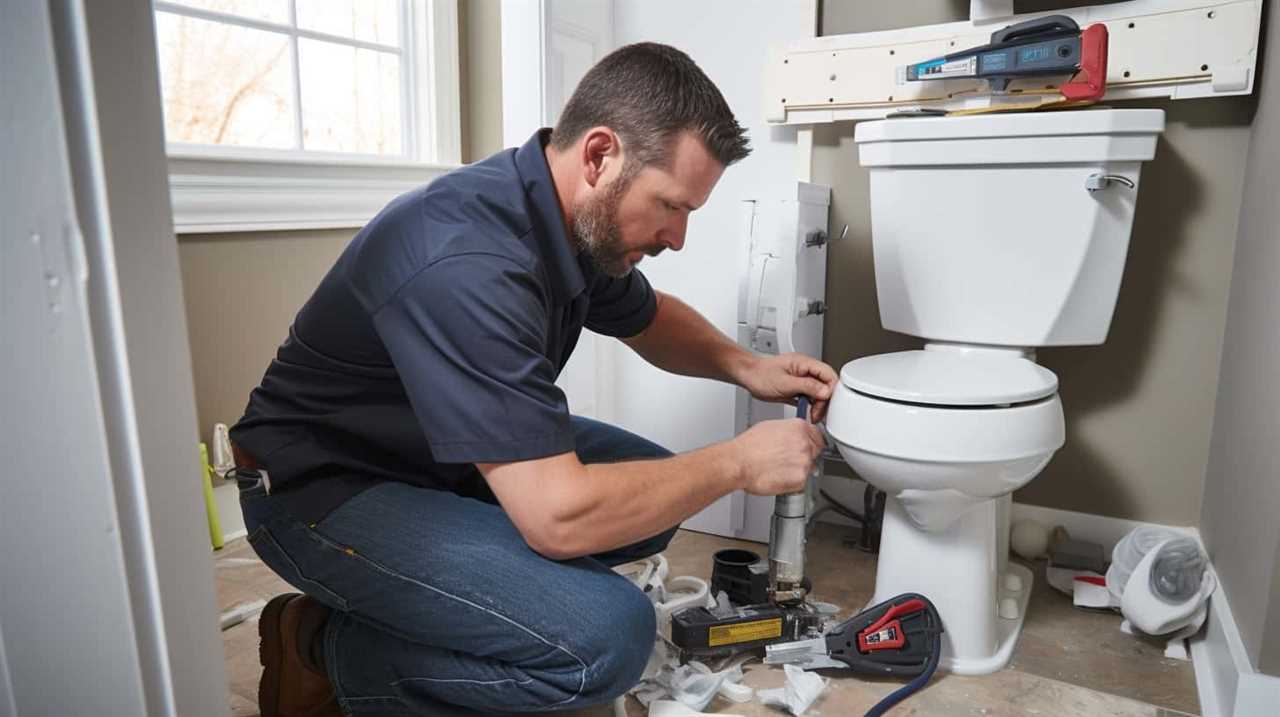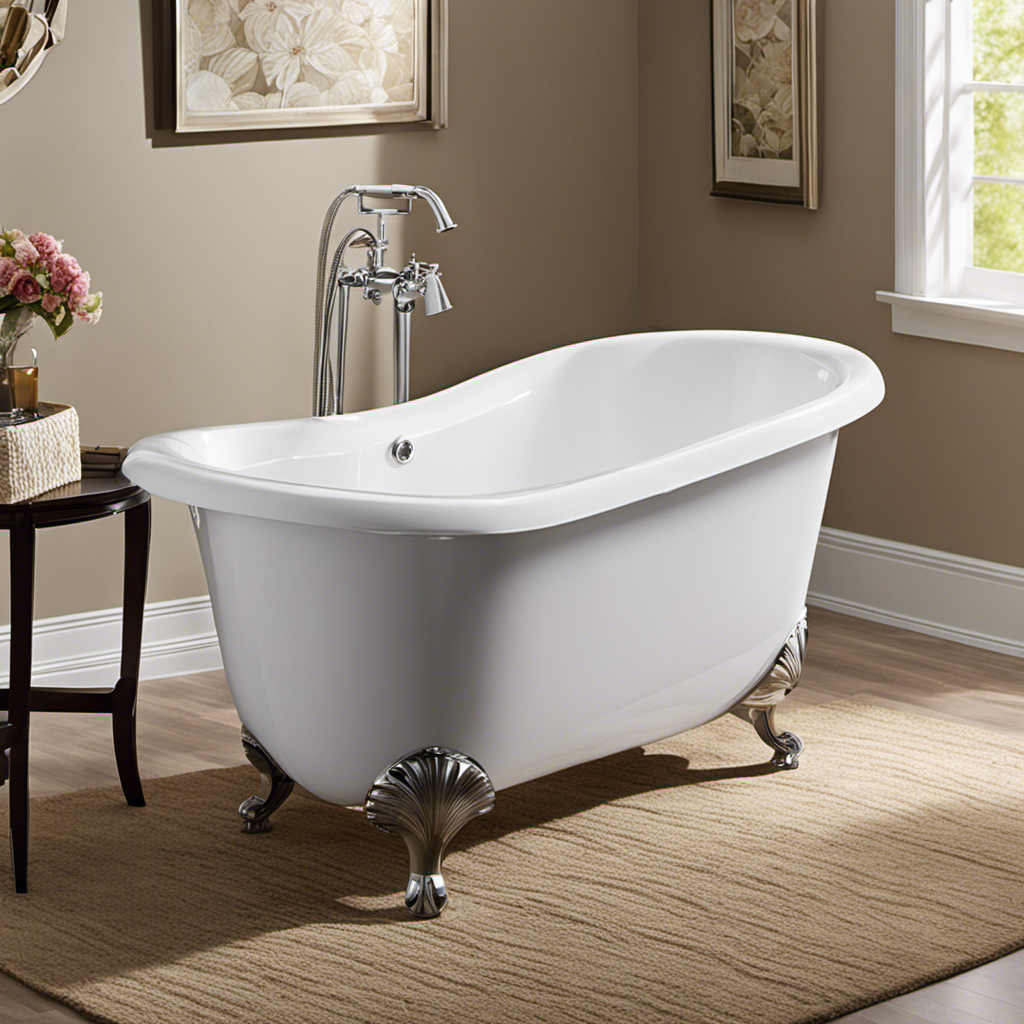As I stood in my bathroom, ankle-deep in water, frustration washed over me. My clogged bathtub drain was causing a flood, and I needed a solution – fast.
In this article, I will guide you through the steps to fix your own clogged drain. By identifying the cause, gathering the necessary tools and materials, and utilizing various unclogging methods, you’ll soon be enjoying a clear and efficient drain, just like I am now.
Let’s dive in and solve this problem together!
Key Takeaways
- Clogged bathtub drains can be caused by hair buildup, soap scum accumulation, mineral deposits, foreign objects, or tree root intrusion.
- Signs of a clogged bathtub drain include slow draining water, standing water in the tub, unpleasant odor, gurgling sounds, and overflowing water.
- Prevent clogged bathtub drains by using a drain strainer, regularly cleaning the drain, avoiding pouring grease down the drain, using a hair catcher, and flushing with hot water regularly.
- DIY methods to unclog a bathtub drain include using a plunger, a mixture of baking soda and vinegar, a drain snake or auger, removing the overflow plate and cleaning the drain, or utilizing a wet/dry vacuum.
Identifying the Cause of the Clog
Before you can fix a clogged bathtub drain, you need to determine what’s causing the clog. To do this, start by inspecting the drain opening for any visible debris such as hair or soap scum. If you can’t see anything, try using a plunger to dislodge the clog.
Make sure to create a seal around the drain with the plunger and then push and pull vigorously to create suction. This should help to break up the clog and allow water to flow freely again. If the plunger doesn’t work, you may need to remove the drain cover and use a plumbing snake to physically remove the clog.
Once you’ve cleared the clog, remember to take preventative measures such as using a drain strainer to catch hair and regularly flushing the drain with hot water to prevent future clogs.
Gathering the Necessary Tools and Materials
To tackle the task at hand, you’ll need to gather a few tools and materials.
Getting started, the first tool you’ll need is a pair of rubber gloves to protect your hands from any chemicals or debris.
Next, you’ll need a plunger specifically designed for drains. This will help create suction and dislodge the clog.
Additionally, a drain snake or auger can be useful for more stubborn clogs.
Make sure to have a bucket or plastic bag nearby to collect any water or debris that may come out during the unclogging process.
Precautions to take include wearing safety goggles to protect your eyes from any splashes or debris, and having a drain cleaner or homemade solution on hand to use if necessary.
With these tools and precautions, you’ll be ready to tackle the clogged bathtub drain.
Removing Hair and Debris From the Drain
Start by grabbing a pair of tweezers to carefully remove any hair or debris that you can easily reach in the drain. This is an important first step in fixing a clogged bathtub drain. Once you have removed the visible hair and debris, it’s time to move on to the next steps.
Here are three techniques you can try to unclog your drain:
-
Use a drain snake: A drain snake is a flexible tool that can be inserted into the drain to break up and remove clogs. Insert the snake into the drain and twist it to catch and remove any blockages.
-
Try the plunger technique: Fill the bathtub with enough water to cover the plunger. Place the plunger over the drain and firmly push down, then pull up quickly. Repeat this motion several times to create suction and dislodge the clog.
-
Apply a mixture of baking soda and vinegar: Pour a cup of baking soda down the drain, followed by a cup of vinegar. Let the mixture sit for about 30 minutes, then flush it out with hot water. This can help dissolve minor clogs and freshen the drain.
Using Chemical Drain Cleaners
Chemical drain cleaners can be a quick and easy solution for unclogging your drain. However, it is important to take safety precautions when using them. Always wear protective gloves and goggles to prevent any contact with the chemicals. Make sure to read and follow the instructions carefully, as improper use can lead to accidents or damage to your plumbing system.
It is also important to keep in mind that chemical drain cleaners are not suitable for all types of clogs. For example, if your drain is completely blocked or if you suspect a more severe issue, it is advisable to seek professional help.
Alternatively, there are other methods you can try before resorting to chemical drain cleaners, such as using a plunger or a drain snake. These methods can be effective and safer options for unclogging your drain.
Trying Natural Remedies for Unclogging the Drain
When it comes to natural remedies for unclogging the drain, two popular methods are using vinegar and baking soda, and the boiling water method.
Vinegar and baking soda create a chemical reaction that can help break down clogs, while boiling water can flush out debris.
I have personally found both methods to be effective in clearing minor clogs in my bathtub drain.
Vinegar and Baking Soda
To begin, you’ll want to grab some vinegar and baking soda to help unclog your bathtub drain. These common household items can be used as an alternative natural remedy to tackle the stubborn clog.
Here are the pros and cons of using vinegar and baking soda:
-
Pros:
- Cost-effective: Vinegar and baking soda are affordable and readily available in most homes.
- Non-toxic: Unlike chemical drain cleaners, vinegar and baking soda are safe for both you and the environment.
- Versatile: Vinegar and baking soda can be used for various cleaning purposes around the house, making them a versatile solution.
-
Cons:
- Effectiveness: While vinegar and baking soda can help unclog mild to moderate clogs, they may not be effective for severe blockages.
- Time-consuming: It may take several attempts and some patience to see results when using vinegar and baking soda.
- Odor: The strong smell of vinegar may not be pleasant for some individuals.
Boiling Water Method
After trying the vinegar and baking soda method with little success, I decided to try another alternative unclogging method for my clogged bathtub drain: the boiling water method. This method involves pouring a pot of boiling water directly into the drain to break up and flush away the clog. It is important to be cautious when handling boiling water to avoid any burns or accidents.
To use this method, simply heat a large pot of water on the stove until it reaches a rolling boil. Carefully pour the boiling water into the drain, making sure to pour it slowly and steadily to avoid splashing. The hot water will help to dissolve any grease or debris that may be causing the clog. Repeat this process a few times if necessary.
While the boiling water method can be effective for minor clogs, it is important to remember that it may not work for more stubborn or severe blockages. If the clog persists, it is recommended to seek professional help for further assistance.
Transition into the subsequent section about seeking professional help: If the clog in your bathtub drain remains stubborn despite trying alternative unclogging methods, it may be time to consider seeking professional help.
Seeking Professional Help
If you’re not sure how to fix a clogged bathtub drain, it might be a good idea to seek professional help. While there are many DIY solutions out there, some clogs can be stubborn and require the expertise of a plumber.
Here are three reasons why seeking professional help is beneficial:
-
Knowledge and Experience: Plumbers have the knowledge and experience to quickly identify the cause of the clog and provide an effective solution. They are trained in various techniques and have access to specialized tools that you may not have.
-
Time and Convenience: Hiring a professional plumber saves you time and effort. They can efficiently fix the clog, allowing you to get back to your daily routine without any hassle.
-
Prevention Advice: A professional plumber can provide valuable tips for preventing future clogs. They can advise you on proper maintenance practices, recommend drain guards, and suggest ways to minimize the risk of future blockages.
Conclusion
In conclusion, fixing a clogged bathtub drain can be a frustrating task, but with the right tools and knowledge, it is definitely achievable. By identifying the cause of the clog and using methods such as removing hair and debris, using chemical drain cleaners, or trying natural remedies, you can successfully unclog your drain.
However, in some cases, seeking professional help might be necessary. For instance, imagine a scenario where a family is eagerly preparing for a relaxing bath after a long day, only to find their bathtub drain completely blocked. With the help of a professional plumber, they were able to quickly resolve the issue and enjoy their well-deserved soak.
Remember, persistence and the right assistance can make all the difference when it comes to unclogging a bathtub drain.










